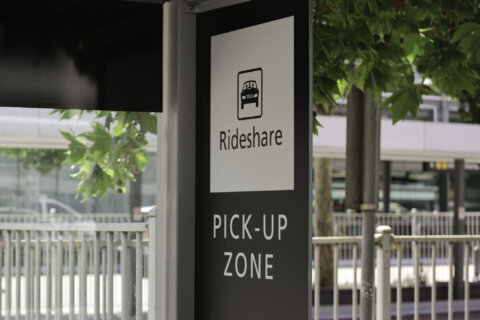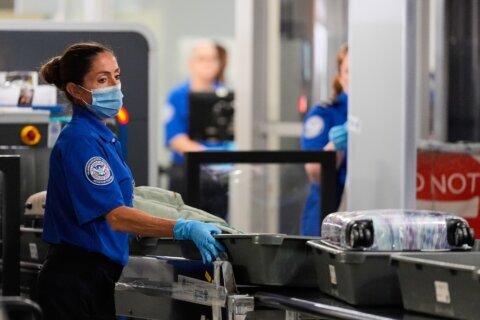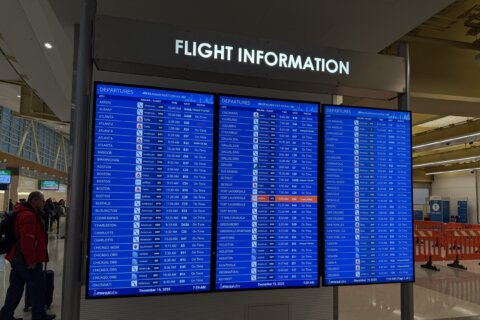(CNN) — It has happened to a model, a medical doctor and a hairstylist, along with many other airline passengers: being singled out or denied boarding on a flight for their fashion choices.
The typical first move for passengers involved: airing their complaints on social media.
That’s what Aurora Culpo did when her sister Olivia Culpo, a model and former Miss Universe, had to cover up her black sports bra and biking shorts with a hoodie before boarding an American Airlines flight to Cabo San Lucas in 2022. Aurora, who was traveling with her sister, slammed American on social media.
Tisha Rowe, a Houston-based physician, also publicly criticized the Fort Worth-based carrier over a July 2019 incident in which she was asked to cover up her “too revealing” floral outfit with a blanket on a flight from Jamaica to Miami.
Another highly publicized incident occurred on Alaska Airlines in August 2021, when police escorted a passenger wearing black shorts and, initially, a crop top off a flight upon landing. The passenger, Ray Lin Howard, a self-described hairstylist and rapper who goes by Fat Trophy Wife online, posted a video on TikTok of herself being questioned by authorities after the flight, which she was allowed to remain on. The video has more than 1.5 million likes and has been shared more than 10,000 times.
Most recently, a passenger took her outrage a step further by retaining high-profile civil rights attorney Gloria Allred after an incident on Delta Air Lines in January 2024. On a flight from Salt Lake City to San Francisco, Lisa Archbold said she was “treated like a criminal” for not wearing a bra under her top. She says she was escorted off the plane by the gate agent and allowed to fly only after she put a shirt over her “revealing” outfit.
Allred held a news conference in late March, entitled “A woman passenger’s breast vs. Delta Air Lines,” sitting alongside Archbold against a backdrop of bras hanging from a clothing rack. Allred also wrote a letter to Delta urging the Atlanta-based carrier to change its policy and requesting a meeting with its president.
“Delta’s current policy, which is highly subjective, has been applied in a discriminatory manner and resulted in disparate treatment and harassment of passengers like Ms. Archbold,” Allred wrote.
Comfort is king
Before the Airline Deregulation Act in 1978, passengers in the United States paid top dollar for airline tickets – and dressed the part, too, donning three-piece suits, dresses and high heels.
Nowadays, comfort is king, and along with shifting cultural norms and trends such as athleisure, most modern-day economy cabins are populated with passengers wearing jeans, T-shirts, hoodies, flip-flops and sometimes even pajamas.
However, even taking into account the new norm of dressing down, the fashion friction that can occur between passengers and airline staff can be partially attributed to the general vagueness of airline policies.
When a passenger buys an airline ticket, they also agree to adhere to the contract of carriage. That’s a legal document that outlines the airline’s policies. But some airlines don’t have an official dress code per se; instead, buried deep in that contract of carriage, is a line or two about what’s prohibited. For many airlines, bare feet is a definite no-go.
Airlines also may establish other parameters around appearance. Delta, for example, says when a passenger’s “conduct, attire, hygiene or odor creates an unreasonable risk of offense or annoyance to other passengers,” they can be removed from the aircraft.
American Airlines simply states its passengers must “dress appropriately; bare feet or offensive clothing aren’t allowed.” Spirit Airlines also bans barefoot passengers, as well as clothing that is “lewd, obscene, or offensive in nature.”
Out of the US carriers’ policies that CNN Travel reviewed, Hawaiian Airlines’ is the most detailed. Under Rule 13, Refusal to Transport, Hawaiian clearly states what’s not allowed on board: bikini bottoms, Speedos and bare feet, along with clothing that’s “lewd, obscene, or patently offensive to others.” It also specifies clothing must “cover the upper part of the torso” – but clarifies that tank tops, tube tops, and halter tops are allowed (as are shorts, but with no specifications about length).
Meanwhile, passengers flying on guest or buddy passes provided by airline employees – non-rev passengers, in aviation lingo – might be under increased scrutiny for their attire, which can also come as a surprise. Case in point: In 2017, a United Airlines employee banned two teenage girls from a flight because they were wearing leggings, a decision the airline defended on social media, resulting in a wave of bad press for the Chicago-based carrier.
‘Gender-focused fashion issue’
The stickiest aspect of most policies is the inherent ambiguity around what terms such as “appropriately,” “lewd” and “offensive” mean, giving airline staffers plenty of leeway in determining what will fly.
Nick Leighton, a Manhattan-based etiquette expert and co-founder of the podcast “Were You Raised by Wolves?”, also notes that what’s considered acceptable or appropriate varies greatly among geographic areas the airline serves.
“Airlines get to decide [their policies], but what cultural standard is it?” Leighton tells CNN Travel. “Is it going to be the Delta headquarters in Atlanta, which is going to be different from, you know, Provence or Los Angeles?”
Those discrepancies – not to mention, the vast cultural differences and backgrounds across airline employees and passengers – can result in some passengers being more targeted than others.
Women, for example, make up the majority of the most publicized incidents. Mary Jo Manzanares, a Seattle-based travel writer who worked as a flight attendant for a US carrier for 33 years, acknowledges there’s “a fair amount of body shaming” involved in many incidents she sees in the media.
“It’s got to do with skimpy attire, [and] that’s generally focused on women, although, to be fair, a man boarding in his Speedo is probably going to elicit the same response,” she says. “But there’s no doubt about it – it’s a gender-focused fashion issue. I wish that it wasn’t.”
In her letter to Delta’s president, Allred also emphasized that imbalance, citing the airline’s contract of carriage that states the carrier “‘may not refuse to provide transportation based upon … sex.’ By denying Ms. Archbold the right to travel in a T-shirt that would be perfectly appropriate for a man, Delta discriminated on the basis of sex.”
Manzanares says she was lucky enough to only face a “small handful” of attire-related incidents during her decades as a flight attendant. But she also points out that many passengers are unaware of the risk of in-flight trouble that can flare up from, say, a seemingly innocuous slogan on a T-shirt. That’s why on-the-ground staff and flight attendants aim to address any potential issues well before takeoff, she says.
“You’ve got to make your priority resolving things on the ground, making sure that there is no aggression,” Manzanares explains. “When you go to 30,000 feet, you may [have] passenger conversation or banter or inappropriate comments between passengers, add in a little alcohol, and you may be making an unscheduled landing. And no one wants that.”
No one wants to be the fashion police
In researching this piece, CNN Travel reached out to the media departments of nearly a dozen major US and international carriers, including those involved in highly publicized incidents around passengers’ attire, for comment about their dress policies and how they respond to complaints.
Only two responded: a spokesperson for KLM and Air France, who declined to comment, and a Southwest spokesperson who told CNN Travel via email the carrier doesn’t have an official dress code. Instead, Southwest “employees are responsible for using their judgment to ensure comfort and safety of all while following our Contract of Carriage,” he wrote. When it comes to personal appearance and hygiene, the contract only states that transport may be refused to barefoot passengers and persons with “an offensive odor.”
Not surprisingly, the task of monitoring passengers’ attire – and asking them to cover up if necessary – isn’t exactly a pleasant one for flight attendants either. “The last thing we want to do is get turned into being the fashion police,” Manzanares says.
But as recent headlines suggest, passengers who push boundaries with what they wear (or don’t wear) risk putting not only themselves in an uncomfortable situation – they could also be inconveniencing hundreds of fellow passengers by causing flight delays.
Addressing potential disruptions before a flight requires precious time and collaboration among airline staff, including the captain (also known as the pilot in command), who ultimately has final say on whether a passenger will be denied boarding, according to aviation site Simple Flying.
Passengers who feel they were unfairly treated can always file a complaint with the airline or the Department of Transportation. But there are no guarantees over compensation or refunds, which are generally made on a case-by-case basis.
In other words, passengers who are denied boarding because of their attire might find themselves footing the bill for their unused ticket (and, potentially, rebooking too). In an incident posted on X on April 1, an American Airlines passenger claims they were denied boarding after paying $2,000 for a first-class ticket because they were wearing an outfit that “offended” someone.
It’s unclear what the outcome was; neither the carrier nor the passenger involved responded to requests for comment. However, passengers also should keep in mind that any out-of-pocket expenses resulting from being denied boarding because of their attire are not likely to be covered by travel insurance.
“Based on my 20+ experience in travel insurance … I have never seen a travel insurance provider cover such incidents,” Jeff Rolander, vice president of claims at Faye Travel Insurance, told CNN Travel via email.
‘Teachable moment’
Leighton, the etiquette expert, notes that other passengers can play a role in avoiding a potentially problematic wardrobe situation by following a simple etiquette rule that also applies in other crowded spaces such as elevators or subways: “Maintaining yourself in your little bubble and not interfering into the bubble of anybody else.”
“That’s why, for example, it’s OK to eat your meal when you’re served,” he explains. “You don’t have to wait for your row to be served – it’s not a dinner party. We’re not together, we are going to pretend we are alone. And so a lot of etiquette is just like, ‘Pretend that this thing isn’t happening.’ ”
When something is particularly challenging to ignore – perhaps an obscene phrase on a T-shirt when you’re flying with young children – Leighton advises parents or caregivers to turn it into a “teachable moment” by explaining that “this is not an appropriate way to dress on an airplane, and it’s happening, but just so you know, in our family, that’s not what we would do.”
According to Kristy Alpert, a Europe-based travel writer originally from the United States who has visited all seven continents, a mindset shift of sorts can be helpful for some passengers while making in-flight wardrobe selections – especially those accustomed to certain cultural norms in some Western countries.
“It’s not me relinquishing my freedom to dress how I want to dress – it’s me showing others a kindness,” explains Alpert, whose father is a retired Delta pilot. “So by me not wearing super-short shorts or wearing a logo that I know is going to offend someone, it’s not me relinquishing my rights to choose what I wear. It’s me being a world traveler, being a global citizen.”
Leighton, meanwhile, says much of the trouble could be avoided if passengers choose their in-flight outfits with personal safety in mind – and, more specifically, how certain clothing and footwear would fare in an emergency situation.
“I want to make sure that if I have to leave this plane in 90 seconds, I’m dressed appropriately,” he explains.
“I always wear natural fibers, long pants and sleeves, and closed-toe shoes when flying because I personally wouldn’t want to be trying to evacuate an aircraft or run away on a tarmac in a tight mini skirt or open-toed sandals. So maybe the focus should be: You need to dress safe.”
The-CNN-Wire
™ & © 2024 Cable News Network, Inc., a Warner Bros. Discovery Company. All rights reserved.







